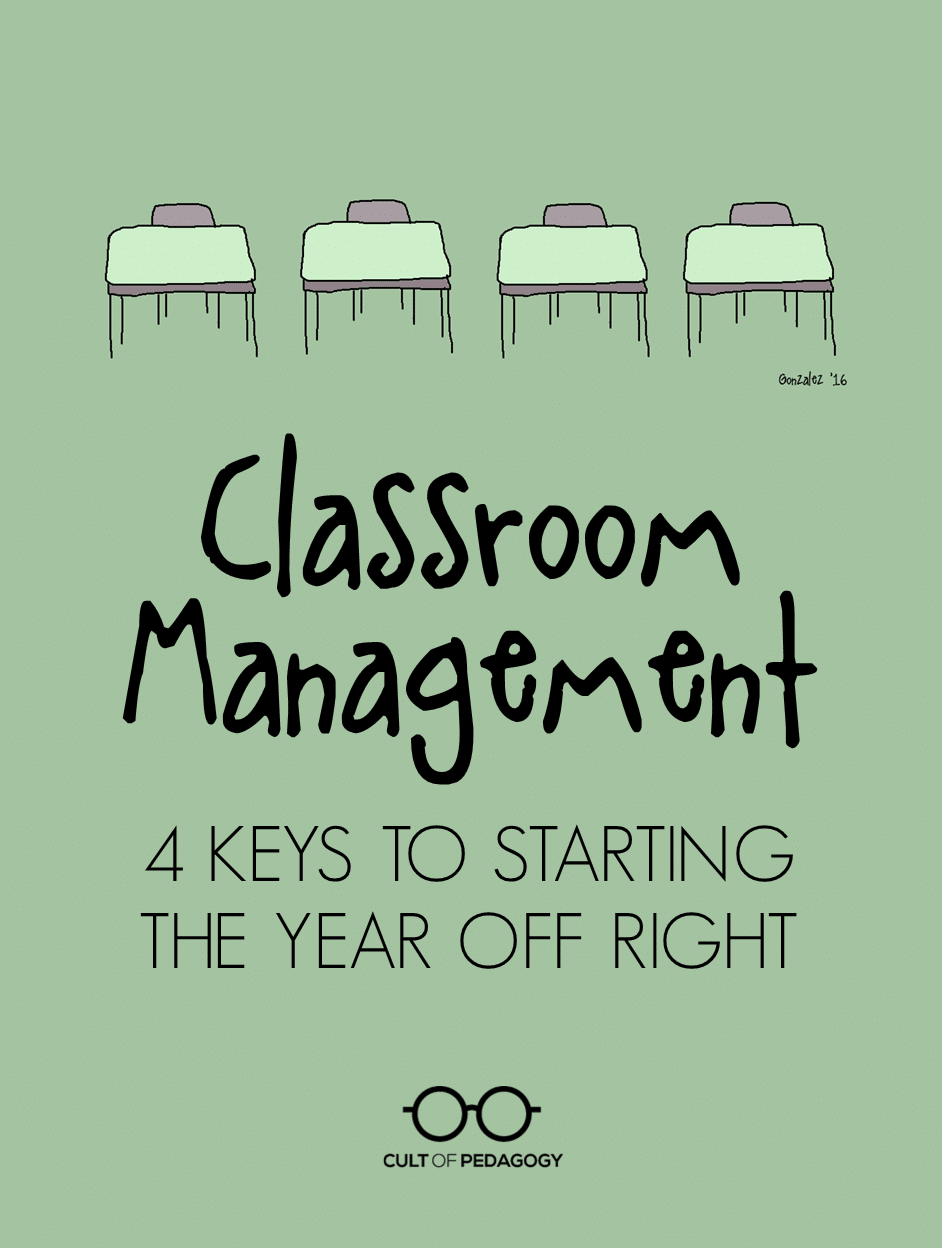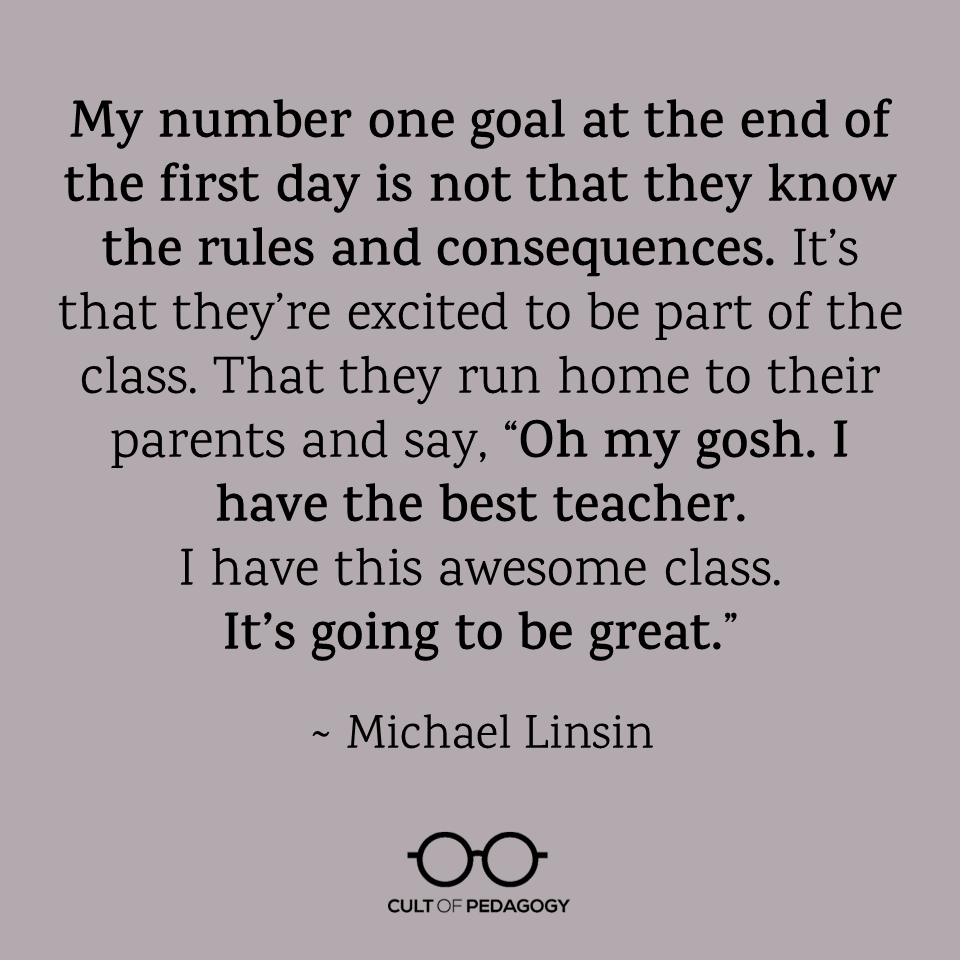Classroom Management: 4 Keys to Starting the Year off Right

Listen to my interview with Michael Linsin here or read a full transcript.
When I was a teacher, classroom management was not my strongest suit. I relied heavily on forming good relationships with my students, thereby preventing misbehavior. This worked about 90 percent of the time; I really didn’t have a whole lot of behavior problems. Unfortunately, the way I dealt with that other 10 percent was rather haphazard: Far too often, I defaulted to the “Wait till there’s a problem, then react” mode.
If I had known about Michael Linsin back then, if I’d had access to the stockpiles of advice he shares on his website, Smart Classroom Management, I would have done things differently.
For you, though, it’s not too late. If you haven’t already discovered Michael Linsin or Smart Classroom Management, this will be a good day for you. Because a few weeks ago, Michael and I spent close to an hour talking on Skype. I asked him to share his advice for teachers implementing a classroom management plan for the school year.

Michael Linsin
For those who want the quick version, I have pulled the four most important points he made—four keys to setting up and implementing a classroom management plan so that it really works—and summarized them here.
Key 1: Have an Actual Plan
My biggest classroom management mistake was that “wait and see” mentality I mentioned before. I never really had a clear plan, and I don’t remember ever giving more than a few minutes to explaining my rules and procedures to students. Honestly, I didn’t want them to think I was mean, or boring, or lame. I wanted to talk about the good stuff on day 1, not bog students down with a bunch of negativity.
And year after year, that bit me in the butt. It’s not that I had badly behaved students, but my lack of clear structure made my job way harder than it had to be. If I’d set up and communicated a clear behavior plan at the beginning of each year, I know I would have enjoyed teaching a lot more.
A classroom management plan should not be complicated. All you need are rules and consequences.
Classroom Rules
Linsin recommends creating a short, simple list of rules. “It’s important just to think about how you can protect your students’ right to learn and also protect your freedom to teach. You want to think about all those behaviors from your experience that are interfering with those two goals, and you create a set of rules as boundaries that protect that freedom.”
In his basic classroom management plan, Linsin recommends including the following rules:
- Listen and follow directions.
- Raise your hand before speaking or leaving your seat.
- Keep your hands and feet to yourself.
- Respect your classmates and your teacher.
Now I’ll tell you this: I have always had my doubts about simple lists like this, because I felt they were way too open to interpretation (and misinterpretation). Too much gray area. But that’s because I didn’t understand how to effectively implement a simple list of rules. Now I do, and I’m going to get into that in Key 2. But first, the consequences.
Classroom Consequences
To accompany the simple list of classroom rules, Linsin recommends a short sequence of consequences for breaking the rules:
- Warning
- Time-out
- Letter home
Linsin acknowledges that these rules and consequences are pretty standard, and he does not insist that all teachers stick to his specific choices. “There is no magic in the rules and consequences themselves,” he says. “It’s how you present them and then how you fulfill them.”
That’s where the magic starts to happen.
Key 2: Teach your plan. REALLY teach it.
This is not the same as “going over” the rules. That’s just reading off a list and basically telling students what you expect. While that’s better than nothing, it isn’t enough. If you want students to really understand exactly how they should behave and exactly what will happen if they don’t, you need to teach your behavior plan as you would any other piece of content. The bulk of this, Linsin says, can be accomplished through detailed modeling of appropriate and inappropriate behaviors.
“Model those rules so there are no misunderstandings about what they mean, and what behaviors they cover. You would model from your perspective as the teacher and as a student, so you may be sitting in a student’s chair with the students surrounding you showing them precisely how to raise their hands.”
Linsin urges teachers to be excruciatingly specific in this modeling. “The more detailed you are, even to a ridiculous degree,” he says, “the more effective and powerful it is. I may show them the actual bend in the elbow of how to raise their hand, the finger placement…”
And after you model the behavior, have the students model it back for you. “You may have the whole class showing you how to raise their hand, how to get up to get a tissue. You may have one model, and then you’ll have five model, and then you’ll have them all model at the same time.”
Although this kind of detailed teaching takes time at the beginning of the year, it ultimately saves you time and frustration later. And it may not be necessary to teach ALL the rules on the very first day. “Let’s say you have time to only model one rule,” Linsin says. “If you model it in a highly detailed way, it transfers. They begin to understand that you’re going to expect that with everything. The first routine you teach of the year, you want to teach the heck out of it, to a remarkable, ridiculous level, because you’re not so much teaching the routine, you’re teaching how to do things the right way. You’re teaching excellence. You’re setting the tone of ‘This is how we do it here. We do things the right way, and we pursue excellence in everything we do.’”
Key 3: Enforce Like a Robot
When it’s time to enforce your rules and consequences, establish some professional distance between you and your students. Execute your plan without getting emotional about it. Linsin advises teachers to be “incredibly personable with the students, and build really close relationships, but when it comes to classroom management, you’re an unfeeling robot almost. Or a referee on a football field. You call them like you see them.”
For a lot of teachers, this is easier said than done. I know it was for me. When students misbehaved, I did kind of take it personally. My heart believed that if they respected me, if they cared about me, then they wouldn’t talk when I was talking, they wouldn’t fool around when they were supposed to be doing something else. It upset me, and I’m sure that showed on my face and in my voice. It added an extra layer of tension and compounded the problem, making the interaction more about the student and me than about the behavior.
It would be far more effective for teachers to train themselves to perceive misbehavior the way Linsin does.
“It’s not me,” he tells himself. “It’s a choice they’re making, and there’s a consequence for that choice. I’m not going to take it personally. I’m not going to feel like that student is doing that because of me.”
He urges teachers to treat infractions quickly and with no emotion. “I believe in never lecturing, scolding, any of that kind of stuff, because every time you do it, it just makes managing your classroom more difficult.”

Key 4: Sell Your Class
Although making sure students have razor-sharp clarity of your behavior plan is essential, it’s just as important to make students want to be in your class.
“You have to sell your program,” Linsin explains. “My number one goal is not that at the end of the day that they know the rules and consequences. It’s that they’re happy and excited to be part of the class. That they run home to their parents and say, ‘Oh my gosh. I have the best teacher. I have this awesome class. We’re going to do this and that this year. It’s going to be great.’ Because that’s what’s going to give you the leverage. The classroom management secret is to create a classroom that students love being a part of.”
So spend lots of time that first day getting students excited about the year, about the learning they’re going to do and the community they will create. “The idea of classroom management, of my website, is not just to get through the day,” Linsin says. “It’s to create an experience those students will remember for a lifetime.” ♦
Michael Linsin is the author of several books on Classroom Management: Dream Class, The Classroom Management Secret, and The Happy Teacher Habits*. His most recent publication is an e-book, The Smart Classroom Management Plan For High School Teachers.
* Some of these are affiliate links. If you make a purchase through these links, I get a small commission from Amazon at no extra cost to you.
Join the Cult of Pedagogy mailing list and get weekly tips, tools, and inspiration—in quick, bite-sized packages—all geared toward making your teaching more effective and fun. You’ll get access to my members-only library of free downloadable resources, including my e-booklet, 20 Ways to Cut Your Grading Time in Half, which has helped thousands of teachers spend less time grading. If you are already a subscriber and want this resource, just check your most recent email for a link to the Members-Only Library—it’s in there!